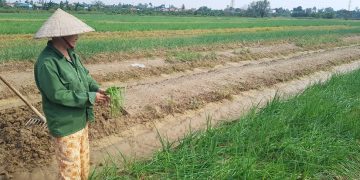#Agriculture #FarmingStrategies #FloodRecovery #SustainablePractices #PestControl #CropManagement #ResilientFarming #AgriculturalInnovation #WeatherImpact #CollaborationinAgriculture
Severe floods have recently devastated agricultural lands, impacting farmers like Chị Nguyễn Thị Dung in Quảng Điền province. Despite facing significant losses due to inundation, farmers are resilient, leveraging sunny weather to assess and salvage crops. According to the Department of Agriculture and Rural Development, the majority of vegetable and flower crops in low-lying areas have been completely damaged.
In response, agricultural authorities are collaborating with local communities to assess necessary seed quantities and propose support measures for farmers. To mitigate flood-related losses, farmers are adopting various strategies. These include timely harvesting of affected crops, destruction of diseased plant material, and enhancing soil aeration to prevent root damage.
Data from the Department of Agriculture and Rural Development:
- Submerged vegetable, cassava, and flower crops in low-lying areas have suffered complete damage.
- Local initiatives involve thorough examination of essential vegetable seed varieties for the proposal of support measures.
- Guidance from agricultural authorities emphasizes adherence to planting schedules to meet high demand during the upcoming Tet festival.
Farmers’ Strategies for Recovery:
- Harvesting: Farmers are actively harvesting waterlogged cassava fields, ensuring the destruction of diseased plants to limit the spread of pathogens.
- Pest Control: Vigilant pest control measures, including the use of Ridomil Gold 68WG, Anvil 5SC, and Vimonyl 72WP, are being implemented to safeguard crops.
- Planning for the Future: Farmers are preparing for the upcoming winter-spring season by carefully selecting and stocking up on diverse vegetable seeds.
Sustainable Farming Practices:
- Aeration and Soil Preparation: After water recedes, farmers are aerating the soil promptly to prevent root congestion and applying supplementary NPK fertilizers.
- Disease Prevention: Rigorous pruning of diseased branches, lime application around tree bases, and the use of Trichoderma and fungicides aid in preventing fungal infections.
- Collaboration and Monitoring: Agricultural authorities are actively monitoring weather conditions, collaborating with local communities, and providing timely support to farmers.
In the face of adversity, the agricultural community is resilient and actively engaged in restoring productivity. The collaboration between farmers and authorities, coupled with the adoption of sustainable practices, is crucial for a successful recovery. As farmers embrace innovation and expert guidance, there is optimism for the revival of agriculture in the affected regions.































